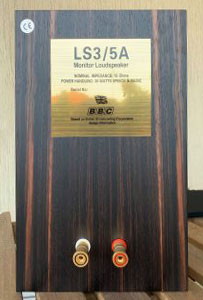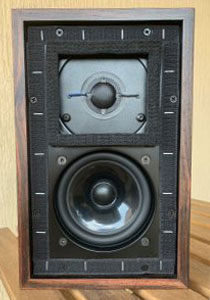Audiomaster21


Abbandonando la BBC nel 1973, il già “mitico” Robin Marshall che aveva lavorato allo sviluppo della altrettanto mitico monitor BBC LS 3/5A, si associa a John Reasd di KJ Leisure Sound col proposito di costruire sistemi di altoparlanti “Hi Quality, BBC sound, Britihsh Style”.
Nel 1975, Audiomaster si ripropone con due modelli: l’iconica LS3/5A e un diffusore di volume doppio.
L’esperienza del progettista Robin Marshall portò anche alla realizzazione di ottime casse acustiche dallo squisito suono, stile BBC ‘MLS1,MLS2,MLS4’ commercializzate alla fine degli anni ’70 che rivaleggiavano con progetti simili in stile BBC: “Spendor SA1 e SA2”, e “Rogers Compact Monitors e LS3/6…”.
Le LS3/5A originali Audiomaster, rigorosamente costruite a mano e individualmente testate e accordate secondo le specifiche BBC, venivano costruite su una piccola linea di produzione. In virtù di questa estrema attenzione costruttiva, le Audiomaster LS3/5A sono oggi particolarmente ricercate nel mercato dell’usato vintage.
English
The original Audiomaster products were introduced by W & N Electronics Ltd., in the mid to late 1950s. Aimed at the higher end of the new burgeoning high fidelity market, the W & N ‘520’ mono amplifier utilised EL34 power pentode valves, and ‘Partridge Transformers’ for a much superior performance. Several highly flexible (mono) control units, boasting superb build and sound were launched to match the ‘W & N Audiomaster 520’. The arrival of stereophonic sound in 1958, saw the launch of the ‘Brecon’ integrated stereo amplifier ( 8 + 8 watts, ECL82 output valves ) to be followed by the ‘Colwyn’ pre & power combination ( 15 + 15 watts, EL84 output valves ) and the ‘Conway’ top of the range stereo pre amplifier designed to run with 2x ‘520’ power amplifiers.
The Sixties saw the introduction of the Audiomaster compact speaker systems : Sonata , Samba and Solent. These 3 models were ideally complementary to the “Abbey Road Sound”.
On leaving the BBC in 1973, the now iconic speaker designer Robin Marshall, having worked on the equally iconic BBC LS3/5a monitor loudspeaker, eventually joins forces with John Read of K. J. Leisuresounds, purposely to manufacture ‘high quality, BBC sound, British style’ loudspeaker systems.
Audiomaster was re-launched in 1975 with two models; the iconic LS3/5a and a 50% larger model called the ‘Image 2’. Robin Marshall’s design experience also went in to the exquisite BBC sound-style ‘MLS 1’, ‘MLS 2’ and ‘MLS 4’ range of models, introduced in the late 70s, and with fidelity rivalling that of similar BBC style designs.
The original Audiomaster LS3/5a was assembled on a small production line, with one-by-one hand assembly, with each individual speaker being tweaked and tuned precisely to the
BBC specifications. This has ensured a very high demand for these classic models on the se- cond-hand market place.
After almost 40 years of a break, the Audiomaster name resurfaces in the twenty first century as “AudioMaster21”, with the LS3/5a.
Oggi a 40 anni di distanza, nel rispetto della tradizionale altissima qualità,
Audiomaster si ripropone nel ventunesimo secolo come “Audiomaster21”, orgogliosi di presentare:
-
The Audiomaster21 LS3/5a Classic 15 Ohm
-
The Audiomaster21 LS3/5a “40th Revival Limited Edition”
-
The Audiomaster21 LS5/9 Classic
Tutti i modelli LS3/5a Audiomaster21 sono costruiti a mano secondo i più alti standard possibili, sono individualmente accordate al modello originale di riferimento per una fedeltà di riproduzione e di accoppiamento, persino migliori delle originali Audiomaster. Costruite in Eu e in UK, utilizzano i recentemente ricostruiti e rinomati tweeter T 27/1032 e “mid bass” B110/1003. Il crossover è copia conforme alle originali specifiche BBC RD1976/29 utilizzando “Radiometal transformer core inductors on the mid/bass unit, and a multi-tap transformer core inductor on the tweeter”.
Il modello “40th Revival Limited Edition” rigorosamente limitato a 40 coppie individualmente numerate, rispetta gli “Kingswood Warren Laboratory Standards “.
LS3/5A
The LS3/5A design was created by the Engineering Department of the BBC. The design brief was to develop a small, broadcast quality monitor loudspeaker. The loudspeaker had to be capable of accurately reproducing the human voice, in outside broadcast applications, yet take up the minimum amount of space.
However, to suit the BBC’s need of minimum downtime, the speaker had to be manufactured to a very tight specification, so that in the event of field failure, the entire speaker could be replaced by another, without affecting the perceived tonal balance, an obvious prerequisite for monitoring purposes.
Almost 5 decades later, these loudspeakers are a superb example of globally enjoyed HiFi, in a historic tradition of innovation and timelessness, which we hope will give much enjoyment. Please read through this manual. It contains much useful information to enable you to get your speakers installed correctly.
You will also find helpful advice on connecting-up, matching equipment, room placement, service and maintenance.
Provided the recommendations are followed your LS3/5a’s will give you many years of pleasure. If advice or service is required please contact the dealer from whom you purchased the product, quoting the serial number and date of purchase.
Unpacking
Always unpack speakers with care so as not to damage the finish. It is advisable to open the packaging at one end, invert the carton with the flaps folded back so the speakers are sitting on the floor. Then remove the packaging from the speakers. Retain all the packaging materials in case you need to transport the speakers at a later date.
Amplifier Interface
It is preferable to carefully use a high quality amplifier of 20-80 watts rated output, avoiding clipping.
The output of most recent amplifiers is quoted into a nominal 8 ohm loudspeaker load. A few (e.g. older Valve [Tube] Amplifiers) may have selectable output positions for use with either 4, 8 or 16 ohms loudspeakers. In this case select the 16ohms output.
Because the “Classic” and the 40th Revival LS3/5a’s have low sensitivity and a nominal 15 ohms impedance, if not using a Valve [Tube] based amplifier rated at 20 watts or more into 16 ohms, we recommend using a solid state amplifier with at least 40 watts output into 8 ohms. This way it is unlikely that the full power setting will be required and this should therefore avoid such clipping damage.
Installation
The LS3/5a’s were designed for small rooms, 12 m2 to 30 m2, bigger rooms might need a stacked solution , with 2 pairs.
Position your speakers approximately where you want them and select cable runs of an ap- propriate quality, length and terminations. Designed specifically for outside broadcasting, the Classic LS3/5a can be positioned close to a boundary wall, however do not position tightly into the corners of a room , “boomy” bass may result.
Ideally, Placing them on mass loaded ( 60-80 cm high ) stands in free space ( away from walls ) can offer an increase in perceived space and depth of playback material.
They should be “toed-in” towards the listening position according to personal preference , the 2 axis’s can cross at the listener or 50-100 cm in front of him.
Furniture and wall coverings also make a considerable difference. We recommend you expe- riment until the best results in your room are obtained.
Note: the connections on the back of the speaker are single wire with 4mm BFA banana sockets or 5 way protected binding posts. The designed frequency response is achieved with the grilles in place. Removal of the grilles will improve transparency, high frequency and mid frequency performance.
Switch off the amplifier. Identify the left speaker of the pair as the speaker on the left when viewed from the listening position.
Connect the black terminal on the amplifier left channel to the black terminal on the left loudspeaker. Then connect the red terminal on the amplifier left to the red terminal on the left loudspeaker. Repeat these connections for the right-hand channel. Check the integrity of the connections and that there are no shorted wires. Turn down the volume and switch on the amplifier. Select a known source and turn up the volume cautiously.
New speakers require a “break in” period. This enables the drive units to settle into their normal working routine and electrical components in the crossover to “bed in”. A minimum of 72 hours playing will see the speakers “broken in” additional playing will continue to improve the overall sound quality.
Connecting cables can have an important effect on the final sound quality. Similar lengths of good quality speaker cable should be used. Your dealer can best advise you of suitable cables for your installation.
Longer cable runs will generally require heavier gauge cables.
All system connections should be clean and tight. Periodically cleaning of all signal path con- nections in your system is recommended. Simply breaking and re-making each connection ensuring a positive contact is all that is needed.
Caring for your loudspeakers
The real wood veneer used on the Classic LS3/5a and 40th Revival LE can be maintained by re- gular dusting and gentle cleaning with furniture polish and a micro fiber cloth. The grille cloth is best kept clean with a soft brush or light vacuum. Do not use undue pressure as you may damage the drive units beneath the grille. Try not to position your speakers in direct sunlight as over time this will cause the veneer to fade.
Technical Specifications
Classic LS3/5a 15 Ohm Monitor Speaker
LS3/5a 40th Revival Limited Edition Monitor Speaker
System Type: Two way infinite baffle ( closed box)
Frequency Response: 70Hz – 20KHz +/- 3dB
Bass/Midrange Driver: 133mm polymer cone
Tweeter: 19mm mylar dome
Crossover Frequency: 3KHz , AudioMaster21 FL6/23 type
Sensitivity: 83dB for 2.83V at 1M
Nominal Impedance: 15 Ohms
Recommended Amplifier Range: 30-80 Watts
( Warning do not connect to any amplifier exceeding range as damage may result ) Cabinet: Cabinet 9-12mm Birch ply critically damped
Grille: Black Acoustic Textile
Dimensions : 304 mm H X 190 mm W X 165 mm D.
Weight 5.5 Kgs each
LS5/9
The LS5/9 design was created by the Engineering Department of the BBC in 1983 . The design brief was to develop a compact, broadcast quality monitor loudspeaker. The loudspeaker had to be capable of accurately reproducing the human voice, and classical music.
However, to suit the BBC’s need of minimum downtime, the speaker had to be manufactured to a very tight specification, so that in the event of field failure, the entire speaker could be replaced by another, without affecting the perceived tonal balance, an obvious prerequisite for monitoring purposes.
4 decades later, these loudspeakers are a superb example of globally enjoyed HiFi, in a historic tradition of innovation and timelessness, which we hope will give much enjoyment.
Please read through this manual. It contains much useful information to enable you to get your speakers installed correctly.
You will also find helpful advice on connecting-up, matching equipment, room placement, service and maintenance.
Provided the recommendations are followed your LS5/9’s will give you many years of pleasure.
If advice or service is required please contact the dealer from whom you purchased the product, quoting the serial number and date of purchase.
Unpacking
Always unpack speakers with care so as not to damage the finish. It is advisable to open the packaging at one end, invert the carton with the flaps folded back so the speakers are sitting on the floor. Then remove the packaging from the speakers. Retain all the packaging materials in case you need to transport the speakers at a later date.
Amplifier Interface
It is preferable to carefully use a high quality amplifier of 20-200 watts rated output, avoiding clip- ping.
The output of most recent amplifiers is quoted into a nominal 8 ohm loudspeaker load. A few (e.g. older Valve [Tube] Amplifiers) may have selectable output positions for use with either 4, 8 or 16 ohms loudspeakers. In this case select the 8ohms output.
Because the LS5/9’s have medium sensitivity and a nominal 8 ohms impedance, if not using a Valve [Tube] based amplifier rated at 20 watts or more into 8 ohms, we recommend using a solid state am- plifier with at least 50 watts output into 8 ohms. This way it is unlikely that the full power setting will be required and this should therefore avoid such clipping damage.
Installation
The LS5/9’s were designed for medium rooms , 20 m2 to 40 m2 .
Position your speakers approximately where you want them and select cable runs of an appropriate quality, length and terminations. Designed specifically for studio broadcasting, the LS5/9’s can be positioned close to a boundary wall, however do not position tightly into the corners of a room , “bo- omy” bass may result.
Ideally, placing them on mass loaded ( 60-80 cm high ) stands in free space ( away from walls ) can offer an increase in perceived space and depth of playback material.
They should be “toed-in” towards the listening position according to personal preference , the 2 axis’s can cross at the listener or 50-100 cm in front of him.
Furniture and wall coverings also make a considerable difference. We recommend you experiment until the best results in your room are obtained.
Note: the connections on the back of the speaker are single wire with 5 way protected binding po- sts. The designed frequency response is achieved with the grilles in place. Removal of the grilles will improve transparency, high frequency and mid frequency performance.
Switch off the amplifier. Identify the left speaker of the pair as the speaker on the left when viewed from the listening position.
Connect the black terminal on the amplifier left channel to the black terminal on the left loudspe- aker. Then connect the red terminal on the amplifier left to the red terminal on the left loudspeaker. Repeat these connections for the right-hand channel. Check the integrity of the connections and that there are no shorted wires. Turn down the volume and switch on the amplifier. Select a known source and turn up the volume cautiously.
New speakers require a “break in” period. This enables the drive units to settle into their normal wor- king routine and electrical components in the crossover to “bed in”. A minimum of 72 hours playing will see the speakers “broken in” additional playing will continue to improve the overall sound quality. Connecting cables can have an important effect on the final sound quality. Similar lengths of good quality speaker cable should be used. Your dealer can best advise you of suitable cables for your installation.
Longer cable runs will generally require heavier gauge cables.
All system connections should be clean and tight. Periodically cleaning of all signal path connections in your system is recommended. Simply breaking and re-making each connection ensuring a positive contact is all that is needed.
Caring for your loudspeakers
The real wood veneer used on the LS5/9’s can be maintained by regular dusting and gentle cleaning with furniture polish and a micro fiber cloth. The grille cloth is best kept clean with a soft brush or light vacuum. Do not use undue pressure as you may damage the drive units beneath the grille. Try not to position your speakers in direct sunlight as over time this will cause the veneer to fade.
Technical Specifications
Constructed from the finest 9mm Baltic Birch plywood
· All joints are hardwood battened with beech fillets
· Balanced real wood veneers
· Cabinet walls critically damped with bituminous damping panels
· Cherry finish as standard
· Other finishes to special order, please ask
Latest version of the 34mm Audax HD34 Tweeter
· Tweeter has been adapted with the addition of a dispersion loading protective plate
· Midrange and Bass are handled by a AudioMaster21 designed 220mm woofer
· Critically flared polypropylene Mid/Bass cone is terminated by an inverted half roll of select vinyl
Single layer high purity copper / fibreglass PCB
· High-quality dividing network uses ten reactive elements
· High-quality dividing network uses 17 resistors
· High voltage Metalised capacitors
· All components hand soldered with hyper solder
· High-frequency level is set by resistor jump links:
– Ensures optimum pair matching
– Essential for monitor use
AudioMaster21 LS5/9 Specifications
· System type: Two way bass reflex
· Tweeter: Audax 34mm with phase correction
· Mid/Bass: AudioMaster21 220 mm polypropylene cone vinyl surround
· Crossover: 3KHz 27 precision element 18dB per Octave
· Sensitivity: 87dB for 1W at 1M
· Nominal Impedance: 8 Ohms
· Power handling: 100 Watts unclipped
· Maximum SPL: 106 dBA typical in room
· Cabinet: 9mm Birch plywood hardwood battens
· Grille: Black Tygan
· Finish: Cherry
· Connections: Stereo pair CE 5 Way Binding Posts
· Dimensions: 460mm x 275mm x 285mm (HxWxD)
· Weight: 12Kg (each speaker)
“L’Eternel Scarabee d’Or de Madame Breyer” alias “The GoldBug”
In 1979-1981, in my University days, the most revered High-End turntable ( among our group of rabid audiophiles ) was the Linn LP12 , with a Breuer Tonearm and a modified EMT XSD15 cartridge ( naked and with a Dr. Weinz Paroc diamond tip , on a Boron cantilever ). The other impossible 1979 French dream being the Goldmund T3 tonearm on a “La Platine Verdier” motor deck, both featured in the “L’Audiophile” magazine that year. Later on, the T3 got its matching motor deck and became the Goldmund Studio and the Verdier “La Platine” bloomed at its best with the Morch 12” tonearms.
In those years, the most popular cartridge “Hot-Roddings” ( i.e. upgrade modifications ) , were done by A.J. Van den Hull in the Netherlands . However, I and our little group of Audio Illuminati, by far preferred the sound of the Paroc profile as invented by Dr. Weinz and manufactured at his WEKA works, in Idar-Oberstein. The VdH , while being very detailed , had a tendency to emphasize the “Vinyl Hiss” ( = surface noise ) and had an overbright sonic edge. The Paroc profile was far more musical, still being very detailed and articulate, but also kind with “older” LPs. The Paroc diamond was also made popular by the Garrott Brothers in Australia ( as Paratrace ) . It was also available on a not so expensive MM cartridge, OEM made by Excel Sound in Japan as Parotronic 77 , A&R P77 and Garrott 77. This inexpensive MM cartridge is still available ( but without the Paroc needle ) as the Sumiko Pearl/Black Pearl , Shelter 201 , Vertere Sabre etc… after 47 years !

For my music listening, of course a student did not have the needed cash for such expensive products, I had an “old” ERA MK6 turntable (a J.C. Verdier previous design ) , with a Morch UP4 tonearm and an electrostatic/capacitor pick-up ( with its dedicated modulator/amplitude RIAA preamp ) , of course modified with the Paroc/Boron upgrade. This was my “Track Day” set up, to be used on “Special & Good” days….
Nowadays there is a lot of talk about optical cartridges (these were already available at the end of the 60s , see the Trio Supreme etc… ) , but if you look at microphones , only the CIA and the KGB use “optical” ones . For high quality music recordings, everybody prefers electrostatic/condenser mics: Neumann U47, U67, AKG C12 etc…
My everyday “heavy duty” turntable was an original Rega Planar 3, with the Koshin Rega R200 Japanese made “S” tonearm, with an EMT XSD15 Tondose (the classic studio sme integrated head shell version), again, with the Paroc/Boron upgrade. This turntable could be used also by “close friends”, due to the uncomplicated set up (worst mishap case, I would resend the cartridge to Dr. Weinz, for repair…).
Now, since I wanted to augment the number of my “Special & Good” days – Electrostatic/Capacitor cartridges are like ELS speakers; while being unique, they react temperamentally to humidity and other ambient/surrounding conditions – I had to find the best candidate to fulfil my needs.
The cartridge that best matched my extreme sonic requirements was the Goldbug Mrs. Brier!
However, since again, the Mr or the Mrs Brier were out of reach financially, after some technical sleuthing, I found out that the MC motor was identical and common to all models, so I started to “hunt” for a less expensive Goldbug Clement….
I luckily found one I could afford, with a broken cantilever, bought it and of course sent immediately to Dr. Weinz for the Paroc/Boron upgrade! I used it for many years in the “naked” form, procrastinating the wooden body for the “future” …Or more exactly did not find anyone wanting to carve one by hand for me! The hot-rodded Clement is still there, in my pick-up harem, in its “naked” beauty!
Now after many decades of music listening, I was nostalgic about the unique qualities (a rare combination of lush sweetness and preternatural detail) of “my” Mrs. Brier’s Goldbug….
One thing leading to another one, I resurrected “The GoldBug”. I found the right accomplice in Lalo Schall , originally a classical music Tonmeister ( specialising in professional acoustic instrument recordings in Austria and Germany ) , now a “secret” designer of ultra-performing and ultra-expensive Swiss and other cartridges. His skills are at par with those of the best Japanese Masters….
The Paroc (now called Paratrace Plus) diamond on the boron cantilever remain, of course. The MC motor has been improved with today’s new materials and the Briar wood body has been changed into Ebony (this leading to even darker silences). The chassis’ metal parts are machined from a Bronze/Aluminium alloy, to keep the harmonic richness of the timbral balance. The generator coils are wound on a square former, taking inspiration from some secret sauce winding techniques learned from the long experience with the EMT MCs. The coils are wound with high spec linear crystal 7N copper wire, silver not being an option for the possible excessive shrill tonal quality. Instead of the now popular Neodymium, we have opted for Samarium Cobalt, for a richer sound structure. The internal impedance has been set to an uncritical 8 Ohm, too low or too high would have created problems for the following preamplifier and/or step-up transformer. This cartridge will work well starting from a Rega RB300 , up to an SME V , but it will shine on a Morch tonearm.
THE GOLDBUG:
1.Weight 9.5 Grams
2.Paratrace Plus 3/30uM diamond on pure Boron rod cantilever.
3.Output 0.35 mV at 3.54 cm/s
4.DCR Impedance: 8 Ohm
5.Frequency Response: 20Hz-20KHz /- 1dB
6.Separation: 30 dB
7.Tracking: 1.8 g (+/- 0.2g)
8.Loading: 200 – 470 Ohm
9.Medium Mass Tonearm preferred.
10.Compliance: 10uM/mN
Audiomaster 21 – Audio Master for the 21st Century…
The original Audiomaster products were introduced by W & N Electronics Ltd., in the mid to late 1950s. Aimed at the higher end of the new burgeoning high fidelity market, the W & N ‘520’ mono amplifier utilised EL34 power pentode valves, and ‘Partridge Transformers’ for a much superior performance. Several highly flexible (mono) control units, boasting superb build and sound were launched to match the ‘W & N Audiomaster 520’. The arrival of stereophonic sound in 1958, saw the launch of the ‘Brecon’ integrated stereo amplifier ( 8 + 8 watts, ECL82 output valves ) to be followed by the ‘Colwyn’ pre & power combination ( 15 + 15 watts, EL84 output valves ) and the ‘Conway’ top of the range stereo pre amplifier designed to run with 2x ‘520’ power amplifiers.
On leaving the BBC in 1973, the now iconic speaker designer Robin Marshall, having worked on the equally iconic BBC LS3/5a monitor loudspeaker, eventually joins forces with John Read of K. J. Leisuresounds, purposely to manufacture ‘high quality, BBC sound, British style’ loudspeaker systems.
Audiomaster was re-launched in 1975 with two models; the iconic LS3/5a and a 50% larger model called the ‘Image 2’. Robin Marshall’s design experience also went in to the exquisite BBC sound-style ‘MLS 1’, ‘MLS 2’ and ‘MLS 4’ range of models, introduced in the late 70s, and with fidelity rivalling that of similar BBC style designs; Spendor SA1 & SA2, Rogers Compact Monitor & LS3/6…
The original Audiomaster LS3/5a was assembled on a small production line, with one-by-one hand assembly, with each individual speaker being tweaked and tuned precisely to the BBC specifications. This has ensured a very high demand for these classic models on the second-hand market place.
After almost 40 years of a break, the Audiomaster name resurfaces in the twenty first century as “Audiomaster21”. We are proud to launch the following models under the Audiomaster21 banner:
-The Audiomaster21 LS3/5a Classic 15 Ohm
-The Audiomaster21 LS3/5a ’40th Revival Limited Edition’
-The Audiomaster21 LS5/9 Classic ( available first quarter 2021 )
All new LS3/5a models will be hand built to the highest possible standards, with each individual loudspeaker fine tuned to a reference, ensuring better fidelity, and pair matching than even the original Audiomaster series of models. Made in the EU and UK.
Newly manufactured and bespoke T27/1032 tweeter units and B110/1003 mid/bass units are used. The crossover is built to the original BBC RD1976/29 specification sheet, using Radiometal transformer core inductors on the mid/bass unit, and a multi-tap transformer core inductor on the tweeter.
The 40th Revival Limited Edition model is strictly limited to just 40 pairs, individually numbered (reservations are starting now, delivery will be January 2021), These models will follow the Kingswood Warren Laboratory Standards.

